Trip to Bolivia and Peru - September 2006
The Bolivia experience
![]()
![]()
![]()
![]()
 Inca Indians, women in colourful chola dresses and
funny bowler hats, kids with snotty noses and sunburned faces, breathtaking sceneries and snow clad mountains, the
world’s largest salt flats, a lake at 3800 meters above sea level, dinosaur
tracks, the lost Inca city of Machu Picchu, llamas, fried guinea pig for
dinner, breathing problems at 5400 meter, biking the world's most dangerous
road…join me in this trip to Bolivia and
Peru in South America!
Inca Indians, women in colourful chola dresses and
funny bowler hats, kids with snotty noses and sunburned faces, breathtaking sceneries and snow clad mountains, the
world’s largest salt flats, a lake at 3800 meters above sea level, dinosaur
tracks, the lost Inca city of Machu Picchu, llamas, fried guinea pig for
dinner, breathing problems at 5400 meter, biking the world's most dangerous
road…join me in this trip to Bolivia and
Peru in South America!
A short summary
This trip report will focus on the trip that I took to Bolivia and Peru in
the period from September 16th to October 2nd 2006. This time I went
together with three friends (Olav, Torbjørn & Svein) and not my wife Nikki.
We went to places like La Paz, Chacaltaya, Torotoro and Salar de Uyuni in
Bolivia, and the main target in Peru was Cuzco and Machu Picchu. I hope that this trip report will contain some
useful information, but it will also have some inside jokes (which always
appears when a group travel together), some “useless” memories, but also
some amusing stories I hope. Please get in touch with me on
gardkarlsen@hotmail.com if you have any questions
or comments. Most pictures are taken by Gard with a Canon Powershot S1 IS
camera but I have also “stolen” some of the photos taken of the rest of the
group. Please check out this
interactive Google map that I have made to see the location of some of
the places that I'm referring to in this trip report.
The report is more or less chronological and it starts of in Bolivia before we take a weekend trip to Peru and then back to Bolivia again. Due to this the report is split into 2 sections: the first one about Bolivia and the second part about the trip to Peru.
Prelude
I had never been to South America before, so when my friend Olav suggested
that we should go and visit his brother Ben Tore, who lives and works in La
Paz in Bolivia, it sounded like a nice opportunity to see a new country and
a new continent. A couple of Ben Tore’s childhood friends also wanted to
visit him, so we ended up being a 4 men team going to South America: my
friend Olav (the IT nerd/musician), Torbjørn (the cop…codename Tobbe), Svein
(minister/male nurse…codename Andrew) and I.
 |
|
Map of Bolivia. Map provided by www.worldatlas.com. |
Planning the trip
For once I didn’t really have to do much planning before a trip. Ben Tore
did most of the planning for us and he came up with a suggestion for a
schedule for our two week stay in Bolivia and Peru. We also used an
acquaintance to buy plane tickets. Olav and Tobbe went by business class,
and Svein and myself decided to fly economy (also nicknamed “cargo” by Olav
and Tobbe). The economy ticket was about 9000 kroner (1400 US $) and it was
quite a route: Stavanger to Copenhagen, Copenhagen to Brussels (where we
would spend the night), Brussels to NYC, NYC to Miami, Miami to La Paz…phew!
The only thing I had to think about was getting the right shots that I
needed, and thinking about what to bring. Due to previous travels I had all
the shots that I needed but I decided to go for a “vaccine” for tourist
diarea. I bought the Lonely Planet Bolivia book (from
Amazon.co.uk) but that
didn’t really put my mind at ease. The section that describes all the
different illnesses that you can get while travelling to Bolivia is
extensive and I have to admit that it made me a bit nervous.
The trip begins
On Saturday September 16th Olav and I went to the airport outside Stavanger
to start our journey. We took the short flight to
Copenhagen, and we had a
few hours to kill at the airport before we met up with the third participant
on this trip; Tobbe. He came in from Kristiansand in Norway and we took the
flight to Brussels together. In Brussels we met up with the fourth guy in
our party, Svein, and we also met Bjørn Inge who lives in Brussels with his
family. He was able to show us a bit around and house us for the night. So
now I can finally say that I have been to Belgium :-) On September 17th we got up early to go to the airport.
Bjørn Inge assured us that it was no point in getting to the airport more
than 2 hours before departure, but let me assure you, if you are going to
the US you need more time than that. The line for checking in was
unbelievable, and us making it in time was more or less a miracle. According
to the information that we got when we came to the airport we should have
been there 4 hours before departure!
Once we checked in we went straight to the gate and into our Boeing 767, and off we went with American Airlines to NYC (JFK). The flight was about 7 ½ hours, and I don’t have a problem coping with flights like that (I tend to get bored on 12-14 hour flights). The plane didn’t have any personal entertainment, and the headset (that was buried deep in the seat pocket) was not very comfortable. We had an entertaining stewardess, but I was not highly impressed by the food (there was only beef left when she came to my row) and the customs form that we had to fill out prior to landing was only available in French!
We had about 6 hours in NYC, and since two of us were
flying business class, we went to the Admirals Club lounge to see if we
could find a place to relax. We were all surprised to find the lounge more
or less empty but at least the bar was open. And with Tobbe’s charm we were
able to get quite a lot of drink vouchers. We ended up having quite a few
Heineken before it was time to move on to Miami. We didn’t have much time
there, and it was just a matter of finding the gate for the flight to La
Paz. So in the evening of 17th we boarded the 757 that would take us to our
destination for this trip: La Paz. Once again I was not that impressed with
the flight…on the plane one of the two lavatories was out of order, they
didn’t have any immigration forms to Bolivia in English (only in Spanish)
etc.
Arriving in Bolivia
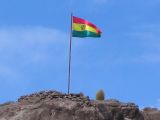 Landing at a new destination is always exciting…what will it be like? Does
it look like you have imagined? etc. When we started our decent to La Paz,
Tobbe handed out Diamox pills (to help against altitude sickness). I more or
less know my limit from my trip to
Kilimanjaro so I decided to not
take the pills. Olav and Tobbe, on the other hand, decided to take them, and
I think it is safe to say that you should be careful taking too many of the
pills :-) . It has side effects that you should read up on before you take
them.
Landing at a new destination is always exciting…what will it be like? Does
it look like you have imagined? etc. When we started our decent to La Paz,
Tobbe handed out Diamox pills (to help against altitude sickness). I more or
less know my limit from my trip to
Kilimanjaro so I decided to not
take the pills. Olav and Tobbe, on the other hand, decided to take them, and
I think it is safe to say that you should be careful taking too many of the
pills :-) . It has side effects that you should read up on before you take
them.
We landed at La Paz international airport early in the morning on Monday September 18th in total darkness. By the time we had gotten through immigration and custom it was starting to get light and we were met by Ben Tore (Olav’s brother) who lives in Bolivia with his family. It was cold outside, but we had been warned so we had brought along warm clothes. The first thing we did was to find an ATM at the airport in order to get some cash. In Bolivia you can use US dollars for lots of things, but their local currency is Bolivianos. Many of the ATMs provide both Bolivianos (also known as Bol) and US dollars.
The airport in La Paz is located on the plateau of El Alto, which is at about 4000 meter (13100 feet) above sea level. I guess this means that you can’t land with all types of aircrafts as the air is pretty thin at this altitude. The air strip is also longer than usual due to this reason (I think it is about 4000 meters long).
First impressions of La Paz
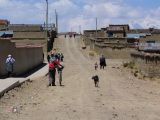 As we drove out of the airport area, we had to go through El
Alto to get
down to La Paz. El Alto is a suburb of La Paz, and most of the people there
live in poverty. So driving through the streets is a bit of a culture shock
when you come from a richer nation: there were garbage in the streets,
people (and dogs) looking through the garbage, stray rabies dogs running
around in groups chasing cars and people, women in typical native outfits
(chola dress and bowler hat) waiting for the bus, small streams of sewage in
the streets, a guy pissing right into the street etc. But it didn’t take
long before we came to the edge of the plateau and started our drive down to
La Paz center. And what a view you get as you drive off the edge….all of a
sudden a valley opens up and you can see a lot of downtown La Paz and the
surrounding mountains….it was beautiful. We were all in awe by the amazing
view of the city that hangs on to the steep slopes of this valley and the
clouds that were drifting around. This must be one of the most spectacular
cities in the world!
As we drove out of the airport area, we had to go through El
Alto to get
down to La Paz. El Alto is a suburb of La Paz, and most of the people there
live in poverty. So driving through the streets is a bit of a culture shock
when you come from a richer nation: there were garbage in the streets,
people (and dogs) looking through the garbage, stray rabies dogs running
around in groups chasing cars and people, women in typical native outfits
(chola dress and bowler hat) waiting for the bus, small streams of sewage in
the streets, a guy pissing right into the street etc. But it didn’t take
long before we came to the edge of the plateau and started our drive down to
La Paz center. And what a view you get as you drive off the edge….all of a
sudden a valley opens up and you can see a lot of downtown La Paz and the
surrounding mountains….it was beautiful. We were all in awe by the amazing
view of the city that hangs on to the steep slopes of this valley and the
clouds that were drifting around. This must be one of the most spectacular
cities in the world!
Casa Alianza – our
sanctuary in La Paz
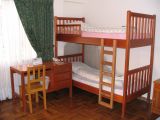 Ben Tore (Olav’s brother) works for
Misjonsalliansen in Bolivia. One of the
tasks he’s got is running a sort of hostel for the volunteers that are
coming to Bolivia to work. So we were lucky enough to get to stay at this
place known as
Casa Alianza. Olav and I shared a big room on the ground
floor. I had a queen size bad while Olav had a bunk bed. The room had a
wooden floor and light painted walls. We also had a separate bathroom with a
bathtub and a shower. The best part of the room was the view of course.
Well, I guess there are many places in La Paz that can offer stunning views
:-)
Ben Tore (Olav’s brother) works for
Misjonsalliansen in Bolivia. One of the
tasks he’s got is running a sort of hostel for the volunteers that are
coming to Bolivia to work. So we were lucky enough to get to stay at this
place known as
Casa Alianza. Olav and I shared a big room on the ground
floor. I had a queen size bad while Olav had a bunk bed. The room had a
wooden floor and light painted walls. We also had a separate bathroom with a
bathtub and a shower. The best part of the room was the view of course.
Well, I guess there are many places in La Paz that can offer stunning views
:-)
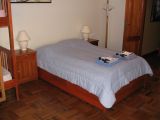 Casa Alianza was filled with young and old
volunteers. Most of these volunteers were from Norway, so if you are
visiting La Paz from Scandinavia it would probably be a good bet to stay at
this place as you can meet people that have stayed there for a while and
that can provide useful tips about where to go and what to see (and where to
party :-). The house is located in the
Obrajes district, so it is not really downtown (well, actually it is down
town but not the center if you know what I mean *grin*). But it is pretty
cheap with taxis in La Paz, and there are also minibuses that can take you
to the center (if you can figure out that system).
Casa Alianza was filled with young and old
volunteers. Most of these volunteers were from Norway, so if you are
visiting La Paz from Scandinavia it would probably be a good bet to stay at
this place as you can meet people that have stayed there for a while and
that can provide useful tips about where to go and what to see (and where to
party :-). The house is located in the
Obrajes district, so it is not really downtown (well, actually it is down
town but not the center if you know what I mean *grin*). But it is pretty
cheap with taxis in La Paz, and there are also minibuses that can take you
to the center (if you can figure out that system).
In the end we paid 220 dollars each for the 14 day stay at Casa Alianza, including the breakfast each morning.
Let’s check this town out
 After we had gotten installed at Casa Alianza it was still early morning. So
we grabbed some breakfast to get some energy. We had breakfast at Casa
Alianza each
morning and it was more or less the same every day: a bit of bread, some
cereal, juice, fruit, tea, yogurt etc. It was quite simple, but good.
According to Ben Tore, breakfast is not really a big thing in Bolivia, and I
guess we were lucky to have a western style breakfast at all :-) Olav
enjoyed a bit of coca tea every morning :-)
After we had gotten installed at Casa Alianza it was still early morning. So
we grabbed some breakfast to get some energy. We had breakfast at Casa
Alianza each
morning and it was more or less the same every day: a bit of bread, some
cereal, juice, fruit, tea, yogurt etc. It was quite simple, but good.
According to Ben Tore, breakfast is not really a big thing in Bolivia, and I
guess we were lucky to have a western style breakfast at all :-) Olav
enjoyed a bit of coca tea every morning :-)
We spent the first day taking it easy and getting used to the altitude. But we also had to organize some stuff…like the trip to Machu Picchu in Peru. So we stopped by a travel agency to get them to organize the bus transport (as there is no flight service between La Paz and Cuzco in Peru anymore), hotels, entrance fees etc.
Before we went off to Bolivia we had also discovered that it was possible to go mountain biking on “The world’s most dangerous road”. So we also stopped by the company “Gravity assisted mountain biking” to organize this trip. Ben Tore did a great job as our driver and guide. I’m not sure that I would have dared to drive in downtown La Paz but I guess you get used to the driving culture after a while.
Valle de la Luna
 But we also had to do a bit of sightseeing on the first day. So Ben Tore
took us to Valle de la Luna (Moon valley). This place is located about 10 km
south of the city, and is an eroded landscape which makes it fascinating.
When we walked around in this landscape I tested the soil several places and
it seemed like pretty loose sandstone. I can’t help thinking that this
landscape must change quite a bit over the years when it rains. It was a bit
surreal to walk around on the paths.
But we also had to do a bit of sightseeing on the first day. So Ben Tore
took us to Valle de la Luna (Moon valley). This place is located about 10 km
south of the city, and is an eroded landscape which makes it fascinating.
When we walked around in this landscape I tested the soil several places and
it seemed like pretty loose sandstone. I can’t help thinking that this
landscape must change quite a bit over the years when it rains. It was a bit
surreal to walk around on the paths.
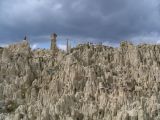 There were not many people there and in
the background we could hear the tunes of a local playing a flute on one of
the canyon tops. We had to pay 15 Bolivianos (about 2 US $) to get into the
area. Be careful and stay on the path, by the way. In some places there was
quite a drop and with the soil being a bit loose, accidents could happen.
And it is of course advisable to not fall on one of the big cacti that are
found in the area. We didn't stay there that long as it started to rain. The
landscape around the area also looked dry and barred and it is hard to see
how anything but cacti could survive there.
There were not many people there and in
the background we could hear the tunes of a local playing a flute on one of
the canyon tops. We had to pay 15 Bolivianos (about 2 US $) to get into the
area. Be careful and stay on the path, by the way. In some places there was
quite a drop and with the soil being a bit loose, accidents could happen.
And it is of course advisable to not fall on one of the big cacti that are
found in the area. We didn't stay there that long as it started to rain. The
landscape around the area also looked dry and barred and it is hard to see
how anything but cacti could survive there.
After a long first day we were all ready to go to bed early. I think we handled the jetlag and altitude pretty good. I continued to stay off the Diamox, but the others stayed on it for a few days until they felt comfortable with the altitude. We also had access to oxygen tanks at Casa Alianza :-)
A drive into the wilderness –
visiting Combaya
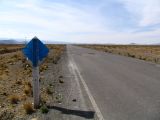 Already on the second day we went on an adventure that would turn out to be
one of the highlights of our entire trip. We had been invited to come along
as Missjonsalliansen were driving to a remote village by the name of Combaya
to place a doctor there. Early in the morning we loaded up three cars with
volunteers, tourists (us :-) ) and missionaries. As we were staying in the
south zone of the city we first had to drive the steep road up to El Alto to
get onto the plateau.
Already on the second day we went on an adventure that would turn out to be
one of the highlights of our entire trip. We had been invited to come along
as Missjonsalliansen were driving to a remote village by the name of Combaya
to place a doctor there. Early in the morning we loaded up three cars with
volunteers, tourists (us :-) ) and missionaries. As we were staying in the
south zone of the city we first had to drive the steep road up to El Alto to
get onto the plateau.
 It was funny to take this drive as we were driving up
and up and all of a sudden you reach a flat plateau. It didn't take us that
long to drive through El Alto and it was quite a contrast to see some of the
houses that were in a sad state against the landscape around. The landscape
is nothing but stunning. The weather was nice and it was amazing to see the
planes against the blue sky and the snow clad mountain tops in the
background. Some of the views were almost unreal….like they had been
constructed as a movie background. Some of the mountain tops like Chacaltaya
and Potosi are 5500 to 6100 meters (18000 to 20000 feet) high, so they are
really impressive.
It was funny to take this drive as we were driving up
and up and all of a sudden you reach a flat plateau. It didn't take us that
long to drive through El Alto and it was quite a contrast to see some of the
houses that were in a sad state against the landscape around. The landscape
is nothing but stunning. The weather was nice and it was amazing to see the
planes against the blue sky and the snow clad mountain tops in the
background. Some of the views were almost unreal….like they had been
constructed as a movie background. Some of the mountain tops like Chacaltaya
and Potosi are 5500 to 6100 meters (18000 to 20000 feet) high, so they are
really impressive.
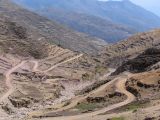 We drove towards Lake
Titicaca, and I think it took us about an hour to reach the lake. After a
short stop in a town to get some lunch, we got off the main road and started
driving towards Combaya on bumpy dirt roads with great views to deep valleys
and high mountains. I'm glad that Ben Tore was equipped with a good Toyota
LandCruiser, because the road was not very good....in fact this is where BBC
TopGear should go to test cars, because the car took quite a beating during
the course of the day!
We drove towards Lake
Titicaca, and I think it took us about an hour to reach the lake. After a
short stop in a town to get some lunch, we got off the main road and started
driving towards Combaya on bumpy dirt roads with great views to deep valleys
and high mountains. I'm glad that Ben Tore was equipped with a good Toyota
LandCruiser, because the road was not very good....in fact this is where BBC
TopGear should go to test cars, because the car took quite a beating during
the course of the day!
 On our way we passed llamas (or maybe it was
alpacas?) and we did have to make quite a few stops to take pictures of the
stunning views. We finally came to a village where we were met by some sort
of parade. It seemed like there was a fiesta going on, and according to what
we found out, the party had been going on for 10 days! It looked like some
of the participants had had a few too many drinks :-)
We stopped by a school in this village that Missjonsalliansen had helped
build. Due to the fiesta some of the kids where home (to take care of
parents with a headache), but we were invited for a tour of the school. Just
a couple of words about drinking: it seems like Bolivians and Norwegians
have something in common; when Bolivians drink beer it is not really to
enjoy the taste...it is to get drunk. One time when we had dinner with Ben
Tore and his family, we had brought a couple of beers for the food, but Ben
Tore's maid was a bit shocked to see that we were going to drink while
having dinner.
On our way we passed llamas (or maybe it was
alpacas?) and we did have to make quite a few stops to take pictures of the
stunning views. We finally came to a village where we were met by some sort
of parade. It seemed like there was a fiesta going on, and according to what
we found out, the party had been going on for 10 days! It looked like some
of the participants had had a few too many drinks :-)
We stopped by a school in this village that Missjonsalliansen had helped
build. Due to the fiesta some of the kids where home (to take care of
parents with a headache), but we were invited for a tour of the school. Just
a couple of words about drinking: it seems like Bolivians and Norwegians
have something in common; when Bolivians drink beer it is not really to
enjoy the taste...it is to get drunk. One time when we had dinner with Ben
Tore and his family, we had brought a couple of beers for the food, but Ben
Tore's maid was a bit shocked to see that we were going to drink while
having dinner.
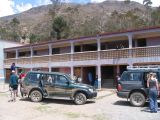 Well, back to the school visit.
The kids were curious due to the sudden influx of lots of strangers. Some of
them had fun just looking at us...and some had fun with the cars as it
didn’t take them long to figure out that if they tapped the cars, they would
trigger the alarms :-). To start with, the kids were shy but they seemed to
warm up after a few minutes. So we did get to take some pictures of them.
Many of the faces are marked by the combination of strong sun and cold
winds. The school even had a room with computers, and they were planning on
giving the kids lessons...the only problem was the lack of a teacher. So if
you want to volunteer I think there is an open position at this school :-)
Well, back to the school visit.
The kids were curious due to the sudden influx of lots of strangers. Some of
them had fun just looking at us...and some had fun with the cars as it
didn’t take them long to figure out that if they tapped the cars, they would
trigger the alarms :-). To start with, the kids were shy but they seemed to
warm up after a few minutes. So we did get to take some pictures of them.
Many of the faces are marked by the combination of strong sun and cold
winds. The school even had a room with computers, and they were planning on
giving the kids lessons...the only problem was the lack of a teacher. So if
you want to volunteer I think there is an open position at this school :-)
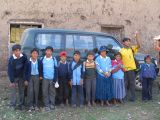 It was not a long drive down to the center of
Combaya,
and this is where we dropped off the doctor that would work there for a
couple of weeks. But we also used the opportunity to pick up a bunch of kids
(I think we managed to squeeze 13-14 people into our car) and drive them
over to their little village a few miles away. It didn't take us that long
to drive this route, but the kids had a 1 1/2 hour walk each way to get to
school!
It was not a long drive down to the center of
Combaya,
and this is where we dropped off the doctor that would work there for a
couple of weeks. But we also used the opportunity to pick up a bunch of kids
(I think we managed to squeeze 13-14 people into our car) and drive them
over to their little village a few miles away. It didn't take us that long
to drive this route, but the kids had a 1 1/2 hour walk each way to get to
school!
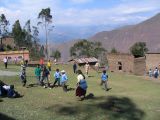 It was not that easy to communicate with them...I don't know any
Spanish, so for me it was impossible. But even for Ben Tore it was a bit
hard, as many of the kids spoke Aymara (one of the Indian languages). But it
is also possible to communicate in other ways...and we choose to do this by
having fun playing soccer :-) We had brought a ball, and there was a small
field in slightly tilting terrain where we could play. It felt like we were
playing on the roof of the world, and when we kicked the ball out of bounds
there was a danger that the ball would drop a few meters :-)
It was not that easy to communicate with them...I don't know any
Spanish, so for me it was impossible. But even for Ben Tore it was a bit
hard, as many of the kids spoke Aymara (one of the Indian languages). But it
is also possible to communicate in other ways...and we choose to do this by
having fun playing soccer :-) We had brought a ball, and there was a small
field in slightly tilting terrain where we could play. It felt like we were
playing on the roof of the world, and when we kicked the ball out of bounds
there was a danger that the ball would drop a few meters :-)
 It was not that easy to play soccer at 3000 meters, as
we were not really used to the altitude yet. But we did our best, and the
main thing was to have fun. I did take some pictures of the kids after the
match and they all wanted to see the pictures. So I was more or less
ambushed by the kids and, I had to work hard to save the camera. But it was
unreal to run around at this altitude...playing soccer with the local
kids...looking at the amazing view.
It was not that easy to play soccer at 3000 meters, as
we were not really used to the altitude yet. But we did our best, and the
main thing was to have fun. I did take some pictures of the kids after the
match and they all wanted to see the pictures. So I was more or less
ambushed by the kids and, I had to work hard to save the camera. But it was
unreal to run around at this altitude...playing soccer with the local
kids...looking at the amazing view.
On the road home we stopped by the town of
Sorata, which seems to be popular
if you are into trekking and the outdoors. We didn't really have that much
time there. We just stopped to get a pizza meal and a beer before heading
home. I think we paid 400 Bolivianos (about 50 $) for 5 large pizzas, beer,
juice, sodas etc and Ben Tore thought it was expensive. I think it was quite
acceptable as it fed about 12 people. I don't think we were home before 10
pm so it was a long day. But it is also a day that I will remember for a
long time. It was quite surreal to drive around in the Bolivian mountains
listening to a CD of the Norwegian artist Bjørn Eidsvåg :-)
Challenge the mountain – on wheels
If you have read this trip report carefully you will have noticed that we
booked a bike trip on the day of our arrival with
Gravity Assisted mountain
biking. We had decided to go for the trip
called “The worlds most dangerous road” and we took the full package for 75$
each.
 So already on day three we were ready to challenge
the mountain – on wheels :-). We had to meet up at a coffee shop at 7.30 am!
But when you have something exciting waiting for you it is not a problem
getting up. All 5 of us squeezed into a taxi (we got very good at this by
the way) and we got there in time. Our guide for the day was James from New
Zealand (a database administrator on a break) and he organized us and
stuffed us into an old American van with the bikes on the roof.
So already on day three we were ready to challenge
the mountain – on wheels :-). We had to meet up at a coffee shop at 7.30 am!
But when you have something exciting waiting for you it is not a problem
getting up. All 5 of us squeezed into a taxi (we got very good at this by
the way) and we got there in time. Our guide for the day was James from New
Zealand (a database administrator on a break) and he organized us and
stuffed us into an old American van with the bikes on the roof.
 The poor van
seemed to struggle in the steep roads leading out of La Paz, and the car
seemed to be stuck in second gear (or was it first :-) ). After about 1 hour
we had come to our starting point at 4700 meters (15400 feet) if I’m not
mistaken. The weather was OK and the air was crisp. It was time to gear up.
Gravity pretty much provided everything…the bike (full suspension with great
hydraulic breaks), helmets, buffs, gloves, goggles, “filthy weather” jacket
and pants etc.
The poor van
seemed to struggle in the steep roads leading out of La Paz, and the car
seemed to be stuck in second gear (or was it first :-) ). After about 1 hour
we had come to our starting point at 4700 meters (15400 feet) if I’m not
mistaken. The weather was OK and the air was crisp. It was time to gear up.
Gravity pretty much provided everything…the bike (full suspension with great
hydraulic breaks), helmets, buffs, gloves, goggles, “filthy weather” jacket
and pants etc.
So we spent a few minutes dressing up and testing out the
bikes to get comfortable. It seemed like Gravity was pretty serious about
the business, as they were explaining everything to us in detail. Before we
started our ride we lined up to make a sacrifice…James had brought along
some 96% spirits that we all had to taste …and then pour some on the front
wheel to “bless” the bike and sacrifice to mother earth. It has been a long
time since I had a taste of something like this and let me put it this way:
small sip people :-). This one girl wanted to show off, so she took a large
gulp and it left her breathless :-).
It was
time to start the ride. We had one guide in the front going fast, and one in
the back to make sure that everybody made it down. We started on asphalt and
it was all downhill, which made it easy to pick up speed. We also had
frequent stops to keep the group together. The Norwegian Team (meaning us)
pretty much stayed in the front. But how long was Adam in paradise? Not long
you say…well, our bike trip also came to a stop pretty fast.
After about ½
hour we stopped, as there was a crowd in the middle of the road. It turned out to
be a demonstration and a road block and they didn’t allow any cars to pass.
So there was not much to do…we had to load up the bikes and torture the old
van again so that we could make it up to the top again where we had
originally started. We eventually made it back to the starting point, but we
continued on dirt roads even higher! In the end I think we must have been
getting closer to 4800 meters (15700 feet) and the landscape looked like the
moon, and it was windy and snowing. We unloaded the bikes again and it was
time to finally go biking for real :-)
I took it easy to start with as the
soil was a bit loose and it was snowing and hailing. I have biked a bit in
my life (yes, I still have a mountain bike that I use from time to time at
home) so I figured that it was better to start slowly and come down in one
piece. But there seemed to be some in our group that were biking faster than
good for their own skills. It didn’t take many minutes before we had the
first accident…we had made it down the main road again and were driving on
slippery and wet asphalt.
We came to an accident site where a car was left
smashed outside of the road. I guess Olav squeezed his front break a bit too
hard (hydraulic breaks are great) and the front wheel just disappeared under
him. He crashed into the ground with his knee and he ripped the pants
provided by Gravity, his own jeans and his warm underwear. Luckily he was
able to continue the bike ride even if he was bleeding a bit and the knee
was sore. We soon got of the main road and we biked on dirt roads all the
way into La Paz. The weather improved gradually and by the time we came to
town it was almost getting too hot with the layers we had on.
The scariest bit of this leg was biking through
poorer areas of La Paz and getting rabid dogs after us :-) . And we also
went over some small streams that seemed to be more sewage than streams.
Towards the end we also had to face a couple of places where it was uphill.
I biked all the way but the last one was very hard…going uphill in about
4000 meters drain you.
The van picked us up again and took us back to the Gravity office. Olav got
some attention to his wound. Even if we had had a pretty nice day there was
growing unrest in the group. Most of the people felt that they had not
really gotten what they had paid for even if the contract was quite clear
about it.
 But I guess what annoyed people was the fact that this
demonstration had been announced on TV the day before so the group was of
course questioning why Gravity had started the tour in the first place. And
this is where it turned a bit ugly…instead of giving in a bit, the Gravity
people in the store turned very arrogant and they really pissed off a few
people in the group. I feel that instead of arguing, they should just have
said that “We’re sorry; we’ll buy you a beer and throw in a CD with pictures
from the trip for free”. But as mentioned, they went the other direction and
turned very arrogant and it even came to the point where they accused Ben
Tore of lying when he said he was living in La Paz. Well, we got so mad that
we just left, but Ben Tore got the number of the owner of Gravity and called
him. We eventually did get a 40 $ discount (for the group) in the end when
Ben Tore had argued with him on the phone for an hour.
But I guess what annoyed people was the fact that this
demonstration had been announced on TV the day before so the group was of
course questioning why Gravity had started the tour in the first place. And
this is where it turned a bit ugly…instead of giving in a bit, the Gravity
people in the store turned very arrogant and they really pissed off a few
people in the group. I feel that instead of arguing, they should just have
said that “We’re sorry; we’ll buy you a beer and throw in a CD with pictures
from the trip for free”. But as mentioned, they went the other direction and
turned very arrogant and it even came to the point where they accused Ben
Tore of lying when he said he was living in La Paz. Well, we got so mad that
we just left, but Ben Tore got the number of the owner of Gravity and called
him. We eventually did get a 40 $ discount (for the group) in the end when
Ben Tore had argued with him on the phone for an hour.
All in all….I hope that you find time to make this bike ride and that you make it to the final destination. Gravity seems like a good company and our guide did a great job under the circumstances. It is a bit sad that the good experience was spoiled by the arrogance of the people in the Gravity office. There are similar companies offering the same bicycle trips, so shop around! Olav’s knee was sore for quite some time after the accident. But luckily our “hotel” was filled with young nurses, and Olav didn’t mind getting his knee checked up from time to time :-)
Eating out at a Peña
With all that fresh air during the day we had built up a bit of an appetite.
Ben Tore took us up into the downtown area. We went to a place called La
Casa del Corregidor which is a typical peñas. A peñas is a place where they
serve food, but they also play traditional folk music. La Case del
Corregidor is located in a nice colonial building and we were basically the
only ones there. It didn’t take long after we had arrived before the band
entered the stage. The 5 man band was very good, and the lead guy impressed
Ben Tore with the flute playing.
We talked to the lead guy after they were
done, and it turned out that he actually made flutes. Svein and Tobbe ended
up buying a flute each and we would hear them each morning at the Casa
Alianza trying to outdo each other with their lack of skills :-). Back to La
Case del Corregidor…the food was OK but some of the potatoes actually looked
a bit scary. We paid 450 Bol (55 $) for the 5 of us and that included a
bottle of wine at about 90 Bol (11 $) and 75 (15 each) Bol (9 $) as a tip
for the entertainers.
But fresh air and biking up hills in high altitude also makes you a bit
tired. So we didn’t stay up long. Already at this point we felt that we had
experienced quite a lot. As Tobbe expressed it “If I was to go home tomorrow
I would say fine…I have been gone for two weeks haven’t I?” And I guess that
is how it felt…we had activities from morning to evening, and people back at
Casa Alianza seemed to be impressed with the activity level we were able to
keep up with :-)
Visiting a
school in El
Alto
 As I mentioned, Ben Tore lives in La Paz and he works for
Misjonsalliansen.
He doesn’t really like to be referred to as a missionary…he prefers to just
call it being a helper. They assist in building schools, help the shoe
polisher boys, and house the volunteers so that they can do their work etc.
We got to learn a bit about this work following Ben Tore around.
As I mentioned, Ben Tore lives in La Paz and he works for
Misjonsalliansen.
He doesn’t really like to be referred to as a missionary…he prefers to just
call it being a helper. They assist in building schools, help the shoe
polisher boys, and house the volunteers so that they can do their work etc.
We got to learn a bit about this work following Ben Tore around.
 One day we
visited a school on El Alto where Misjonsalliansen is involved. They are
involved with building a better school, educating the kids when it comes to
dental hygiene etc. We visited the school El Progreso (which means “progress”)
on morning. When we came to the school the school yard was all empty. It
turned out that it was a day for celebration…it was both spring day and
student day. So each class was in their class rooms enjoying cakes and
sodas. We went from class to class and said hi. In some classes they had
Miss. and Mr. class competitions….
One day we
visited a school on El Alto where Misjonsalliansen is involved. They are
involved with building a better school, educating the kids when it comes to
dental hygiene etc. We visited the school El Progreso (which means “progress”)
on morning. When we came to the school the school yard was all empty. It
turned out that it was a day for celebration…it was both spring day and
student day. So each class was in their class rooms enjoying cakes and
sodas. We went from class to class and said hi. In some classes they had
Miss. and Mr. class competitions….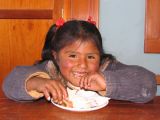 I guess you have to start early if you
want to become Miss Universe :-) We were taken a bit off guard when we came
into one class room and the teacher started chopping up cake and jelly for
us. At first we were a bit reluctant as we had a bit of fear that it might
lead to stomach problems…but Ben Tore reminded us that it would be rude to
decline food, so we just had to dig in. The cake was not bad at all, and you
can’t really go wrong with jelly :-) It seems like the poor kids around La
Paz are not suffering from a lack of nutrition…but rather from mal
nutrition. They eat too much sugar and this leads to problems with the teeth
etc. But I guess when there is a fiesta one must be allowed to splurge :-)
I guess you have to start early if you
want to become Miss Universe :-) We were taken a bit off guard when we came
into one class room and the teacher started chopping up cake and jelly for
us. At first we were a bit reluctant as we had a bit of fear that it might
lead to stomach problems…but Ben Tore reminded us that it would be rude to
decline food, so we just had to dig in. The cake was not bad at all, and you
can’t really go wrong with jelly :-) It seems like the poor kids around La
Paz are not suffering from a lack of nutrition…but rather from mal
nutrition. They eat too much sugar and this leads to problems with the teeth
etc. But I guess when there is a fiesta one must be allowed to splurge :-)
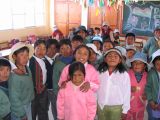 It was fun to visit the school to see how
Misjonsalliansen has been able to help improve it with the help of the
mothers. It was fun to meet so many kids…as you can see from the pictures
typically Bolivian with skin marked by the sun and cold winds and snotty
noses :-).
Misjonsalliansen also runs the same kind of business as the Nobel Peace
Prize winner Muhammad Yunus. They give out micro credit loans when people
can’t get loans from banks. We visited a couple of people that has taken up
loans.
It was fun to visit the school to see how
Misjonsalliansen has been able to help improve it with the help of the
mothers. It was fun to meet so many kids…as you can see from the pictures
typically Bolivian with skin marked by the sun and cold winds and snotty
noses :-).
Misjonsalliansen also runs the same kind of business as the Nobel Peace
Prize winner Muhammad Yunus. They give out micro credit loans when people
can’t get loans from banks. We visited a couple of people that has taken up
loans.
 First we made a stop at wood carver. He had a small shack where he
made his stuff and he was chewing away on his coca leaves. We got to try
some but it didn’t really taste all that great if you ask me. And from what
I read, you have to keep it in your mouth for at least 15 minutes to get
some effect.
Bolivia is also known for their knitted products…or to be more precise:
knitted products made from alpaca wool :-). I ended up buying 2 typical
hats, a scarf and a sweater for an infant, and it cost me 65 Bol (8 $).
First we made a stop at wood carver. He had a small shack where he
made his stuff and he was chewing away on his coca leaves. We got to try
some but it didn’t really taste all that great if you ask me. And from what
I read, you have to keep it in your mouth for at least 15 minutes to get
some effect.
Bolivia is also known for their knitted products…or to be more precise:
knitted products made from alpaca wool :-). I ended up buying 2 typical
hats, a scarf and a sweater for an infant, and it cost me 65 Bol (8 $).
 Misjonsalliansen is also involved in getting kids active in
sports. One of
their projects has been participating in the building of the stadium at El
Alto. The stadium was very nice, with artificial grass (as I guess grass
does not grow that well at 4000 meters) and with a beautiful view. How they
are able to play a full soccer match at 4000 meters is another question. I
don’t think that we would last long running in this thin air. As we drove out of El Alto we saw this one building that had a funeral
agency on the second floor. And on the ground floor there was a butcher with
a big poster saying “Fresh meat” :-). We found this to be a bit funny.
Misjonsalliansen is also involved in getting kids active in
sports. One of
their projects has been participating in the building of the stadium at El
Alto. The stadium was very nice, with artificial grass (as I guess grass
does not grow that well at 4000 meters) and with a beautiful view. How they
are able to play a full soccer match at 4000 meters is another question. I
don’t think that we would last long running in this thin air. As we drove out of El Alto we saw this one building that had a funeral
agency on the second floor. And on the ground floor there was a butcher with
a big poster saying “Fresh meat” :-). We found this to be a bit funny.
 On this day the weather was beautiful, so we had to
make a stop as we were going over the edge from El Alto to La Paz. Once
again the view of the city was amazing with the surrounding snow clad
mountains. But for a new visitor to the city, locating the center of town
could be difficult. But with Ben Tore’s help we were able to find different
landmarks, like the cathedral etc. I have marked one lookout point on the
Google map where you can stop and take pictures like the one in this section.
On this day the weather was beautiful, so we had to
make a stop as we were going over the edge from El Alto to La Paz. Once
again the view of the city was amazing with the surrounding snow clad
mountains. But for a new visitor to the city, locating the center of town
could be difficult. But with Ben Tore’s help we were able to find different
landmarks, like the cathedral etc. I have marked one lookout point on the
Google map where you can stop and take pictures like the one in this section.
The following day we took a trip to Peru to see Machu
Picchu and you can read about the trip in this trip report. This report
continues as we arrive back again in Bolivia.

Resting day in La Paz – and off again
This report continues as we come back to La Paz after the trip to Peru.
 We spent the day relaxing, washing clothes…general recovery again. But the
following morning we where off again. The destination this time was Salar De
Uyuni (the world’s largest salt flat) and Torotoro national park. With
little and precious time, we decided to fly instead of taking bus, train and
jeep tour. Ben Tore had gotten a hold of Eugen, the Swedish missionary, to
take care of the transportation (he is listed in Lonely Planet under Free
Swedish Mission of Cochabamba). We teamed up with Eugen at the airport, and
he took us out to his 6 seats Cessna. Soon we took off and got a great view
of El Alto. Olav was in seventh heaven as he got the co-pilot seat. He was
allowed to control the plane for a while…maybe that is why Ben Tore got a
bit air sick :-)
We spent the day relaxing, washing clothes…general recovery again. But the
following morning we where off again. The destination this time was Salar De
Uyuni (the world’s largest salt flat) and Torotoro national park. With
little and precious time, we decided to fly instead of taking bus, train and
jeep tour. Ben Tore had gotten a hold of Eugen, the Swedish missionary, to
take care of the transportation (he is listed in Lonely Planet under Free
Swedish Mission of Cochabamba). We teamed up with Eugen at the airport, and
he took us out to his 6 seats Cessna. Soon we took off and got a great view
of El Alto. Olav was in seventh heaven as he got the co-pilot seat. He was
allowed to control the plane for a while…maybe that is why Ben Tore got a
bit air sick :-)
 After about 1 ½ hours we reached some wetlands, and
Eugen took the plane really low. There were thousands of pink flamingoes on
the lake and getting into the air when they heard the noise from the plane.
For a while I felt like I was in the opening scene of a National Geographic
show :-). Soon after we reached the salt flats. Salar De Uyuni is huge…about
12.000 square kilometers. It is not easy to understand how huge this is so
I
have compared it to the NYC area (the blue outline shows the size of it). It was quite amazing to fly over this vast
area of white salt and a bit spooky to land on it. But we landed without any
problems near a salt hotel.
After about 1 ½ hours we reached some wetlands, and
Eugen took the plane really low. There were thousands of pink flamingoes on
the lake and getting into the air when they heard the noise from the plane.
For a while I felt like I was in the opening scene of a National Geographic
show :-). Soon after we reached the salt flats. Salar De Uyuni is huge…about
12.000 square kilometers. It is not easy to understand how huge this is so
I
have compared it to the NYC area (the blue outline shows the size of it). It was quite amazing to fly over this vast
area of white salt and a bit spooky to land on it. But we landed without any
problems near a salt hotel.
 I guess the
salt hotel is the equivalent of the ice
hotels in Norway and Finland. At the salt hotel everything is made out of
salt…beds, chairs, tables…everything. It was great to have a toilet break
(even if it cost us 5 Bolivianos) and we also had some drinks. Remember to
bring sunglasses. With the bright light from the sun reflecting from the
white salt, the light is blinding. It was similar to being out in a
landscape full of snow on a bright and sunny day.
I guess the
salt hotel is the equivalent of the ice
hotels in Norway and Finland. At the salt hotel everything is made out of
salt…beds, chairs, tables…everything. It was great to have a toilet break
(even if it cost us 5 Bolivianos) and we also had some drinks. Remember to
bring sunglasses. With the bright light from the sun reflecting from the
white salt, the light is blinding. It was similar to being out in a
landscape full of snow on a bright and sunny day.
 After we had taken a few pictures, we took off again
and followed the trail that numerous jeeps had left in the salt. After a few
minutes we landed near Isla de los Pescadores (Isla Inca Huasi). This is a
small island that sticks up of the salt, and it is filled with huge cacti.
After we had taken a few pictures, we took off again
and followed the trail that numerous jeeps had left in the salt. After a few
minutes we landed near Isla de los Pescadores (Isla Inca Huasi). This is a
small island that sticks up of the salt, and it is filled with huge cacti.
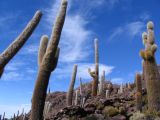 I’m not sure what these cacti survive on but some of them were like 10
meters high and they claim they only grow 1 cm per year … they have been
around for a while. We paid 10 Bolivianos (1.25 US $) for the entrance and
followed the path around the island to get a closer look at the cacti.
There were quite a lot of jeeps on the “parking lot” at the island and some
people seemed very surprised when we rolled in with our plane :-) All of a
sudden it seemed like that was the main attraction for the visitors. After
about an hour on the island we took off again and headed towards the
national park of Torotoro located northeast of Salar De Uyuni.
I’m not sure what these cacti survive on but some of them were like 10
meters high and they claim they only grow 1 cm per year … they have been
around for a while. We paid 10 Bolivianos (1.25 US $) for the entrance and
followed the path around the island to get a closer look at the cacti.
There were quite a lot of jeeps on the “parking lot” at the island and some
people seemed very surprised when we rolled in with our plane :-) All of a
sudden it seemed like that was the main attraction for the visitors. After
about an hour on the island we took off again and headed towards the
national park of Torotoro located northeast of Salar De Uyuni.
Torotoro – dinosaur tracks, canyons and caves
The flight from Salar De Uyuni took maybe an hour and we ran into bad
weather. But Eugen was able to find the open holes that he needed to fly
through. The landscape around Torotoro was spectacular…mountains, canyons,
strange geology etc. Eugen dove into some of the canyons, which gave us all
quite a rush! It was like riding a huge roller coaster :-) The “airport” at
Torotoro was just a grassy height next to the village. When we came around
for the first landing Eugene all of a sudden pulled up.
 At first we though
he had missed on the strip, but it soon turned out that a cow was standing
in the middle of the runway, and it wasn’t really willing to move. I think
we had to pass the cow 5-6 times before it got scared and gave room for us
to land. We had strong tail winds, which added to the excitement. Due to the
bad weather Eugen didn’t stay long…we got our baggage out of the plane and
started the 10 minute walk down to the village of Torotoro.
At first we though
he had missed on the strip, but it soon turned out that a cow was standing
in the middle of the runway, and it wasn’t really willing to move. I think
we had to pass the cow 5-6 times before it got scared and gave room for us
to land. We had strong tail winds, which added to the excitement. Due to the
bad weather Eugen didn’t stay long…we got our baggage out of the plane and
started the 10 minute walk down to the village of Torotoro.
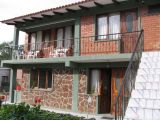 We stayed at a place called “Las Harmanas”, a small
hostel run by the lovely Lilly. Ben Tore had been in touch with her before
we came, so she was sort of expecting us. Olav and I shared a room. It was
pretty tiny and naked…and the toilet/shower was outside. It had been a long
day and it was starting to rain, so Olav, Tobbe and I went for a beer at a
small restaurant. There was no one else when we came there but a small boy
finally came. Finally we got to use a few of the words we know in Spanish
“cerveza por favor” :-)
We stayed at a place called “Las Harmanas”, a small
hostel run by the lovely Lilly. Ben Tore had been in touch with her before
we came, so she was sort of expecting us. Olav and I shared a room. It was
pretty tiny and naked…and the toilet/shower was outside. It had been a long
day and it was starting to rain, so Olav, Tobbe and I went for a beer at a
small restaurant. There was no one else when we came there but a small boy
finally came. Finally we got to use a few of the words we know in Spanish
“cerveza por favor” :-)
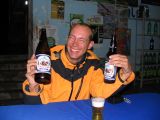 But of course the boy had to go and ruin in it by
asking us something back :-) We finally understood that he was asking what
size we wanted, so we tried to communicate with finger language that we
wanted three small beers. When he came back we were a bit surprised as he
served 3 bottles that were 0.625 liter each (about 1.3 US pints). So we had
a bit of a laugh about us not even being able to use finger language to
order beer, because the bottles were not small according to our definition.
After we had finished the beer we ordered one more to share, and we told the
boy to bring a grande cerveza. We were shocked when he came with an even
bigger bottle…this time 1 liter. So it turned out that that first bottles we
got was the small ones. Anyway, it was excellent with a Taquiña.
But of course the boy had to go and ruin in it by
asking us something back :-) We finally understood that he was asking what
size we wanted, so we tried to communicate with finger language that we
wanted three small beers. When he came back we were a bit surprised as he
served 3 bottles that were 0.625 liter each (about 1.3 US pints). So we had
a bit of a laugh about us not even being able to use finger language to
order beer, because the bottles were not small according to our definition.
After we had finished the beer we ordered one more to share, and we told the
boy to bring a grande cerveza. We were shocked when he came with an even
bigger bottle…this time 1 liter. So it turned out that that first bottles we
got was the small ones. Anyway, it was excellent with a Taquiña.
The decent – exploring the Umajalanta cave
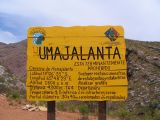 One of the goals for visiting Torotoro was to visit the
Umajalanta cave
located a bit outside the village. We got up early in the morning and we got
breakfast from Lilly. From there we went to the village administration to
register and pay the entrance fee…it was only 20 bolivianos each (about 2.5
US $). We also got a hold of some cheap flashlights that we could bring
along. I said that the cave is a bit outside town…well it is 8 km (about 5
miles) out of town and Olav’s knee was still sore after the biking incident
in La Paz. This was a bit of a dilemma, but it turned out that a couple that
we had talked to at Lily’s were going the same way in their 4X4 so we got a
ride.
One of the goals for visiting Torotoro was to visit the
Umajalanta cave
located a bit outside the village. We got up early in the morning and we got
breakfast from Lilly. From there we went to the village administration to
register and pay the entrance fee…it was only 20 bolivianos each (about 2.5
US $). We also got a hold of some cheap flashlights that we could bring
along. I said that the cave is a bit outside town…well it is 8 km (about 5
miles) out of town and Olav’s knee was still sore after the biking incident
in La Paz. This was a bit of a dilemma, but it turned out that a couple that
we had talked to at Lily’s were going the same way in their 4X4 so we got a
ride.
 There was an administration house near the cave
entrance and we got a young guy to guide us when we went into the cave. We
didn’t get very far into the cave before we had to get down on our knees to
get through. Olav and Svein decided that they would rather wait outside for
us. Too bad for them! Tobbe, Ben Tore and myself continued and I’m really,
really glad that we had a guide.
There was an administration house near the cave
entrance and we got a young guy to guide us when we went into the cave. We
didn’t get very far into the cave before we had to get down on our knees to
get through. Olav and Svein decided that they would rather wait outside for
us. Too bad for them! Tobbe, Ben Tore and myself continued and I’m really,
really glad that we had a guide.
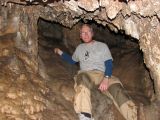 From time to time we had to use a rope to
get down steep, slippery edges and the flashlights that we had bought were
absolute crap. When we came to the “bottom” of the cave we found a nice sand
area and it felt just like beach sand. We turned off the lights and it was
total darkness and all we could hear was the river that runs inside the
cave. I thought we had reached the bottom but the guide indicated that we
were going to continue.
From time to time we had to use a rope to
get down steep, slippery edges and the flashlights that we had bought were
absolute crap. When we came to the “bottom” of the cave we found a nice sand
area and it felt just like beach sand. We turned off the lights and it was
total darkness and all we could hear was the river that runs inside the
cave. I thought we had reached the bottom but the guide indicated that we
were going to continue.
 Now we had to get down and crawl in the sand and
follow a narrow passage under the rocks. I’m not too fond of really narrow
spaces, at least not after seeing movies like The Decent and The Cave. But
luckily the narrow passages were only a few meters…and then we came into the
cave where the river was running. But there were dangers here as well. At
one place we had to lower ourselves from a ledge down to a board that was
jammed into place…and it was several meters down. I think the tour of the
cave took about 2 hours and I was pretty pleased when I saw daylight again.
Now we had to get down and crawl in the sand and
follow a narrow passage under the rocks. I’m not too fond of really narrow
spaces, at least not after seeing movies like The Decent and The Cave. But
luckily the narrow passages were only a few meters…and then we came into the
cave where the river was running. But there were dangers here as well. At
one place we had to lower ourselves from a ledge down to a board that was
jammed into place…and it was several meters down. I think the tour of the
cave took about 2 hours and I was pretty pleased when I saw daylight again.
If you are planning to do this cave, here’s my advice:
- Bring a good flashlight. The cheap, Chinese flashlights we bought in Torotoro were useless.
- Bring a hard hat and a head lamp so that you can have both hands free and protect your head
- Put on clothes that you are not afraid of…you will get dirty!
- Are you claustrophobic? Or are you not used to a bit of physical challenges? My recommendation is that you stay outside. This cave would possibly not be open for the general public in other parts of the world
- Remember that the temperature in the cave is pretty constant…and it is only about 10 degrees (50 Fahrenheit)
- Remember to bring water…and that you also have to walk back to town :-)
 The cave was an amazing experience. There were
lots of stalagmite and stalactite in the cave, and it was beautiful. But
there was also quite a lot of tagging and formations that were chipped off
by visitors. After the tour of the cave it was a bit of an
anti-climax to start the 8 km walk back to town. Olav limped next to us
due to his sore knee, but we did get back to the village eventually. After
all the exercise, it was great to head back to our small bar to have an
ice cold Taquiña. But we also took a short walk before dinner to check out
some dinosaur tracks near by.
The cave was an amazing experience. There were
lots of stalagmite and stalactite in the cave, and it was beautiful. But
there was also quite a lot of tagging and formations that were chipped off
by visitors. After the tour of the cave it was a bit of an
anti-climax to start the 8 km walk back to town. Olav limped next to us
due to his sore knee, but we did get back to the village eventually. After
all the exercise, it was great to head back to our small bar to have an
ice cold Taquiña. But we also took a short walk before dinner to check out
some dinosaur tracks near by.
A walk with Mario – The canyon of El Vergel
 We asked a bit around to find a guide to take us around one day, and a guy
named Mario was suggested. When we asked Lilly about him she only replied
“You better watch out so he doesn’t steal your things” and from others we
heard that he spent a bit too much money on drinking.
We asked a bit around to find a guide to take us around one day, and a guy
named Mario was suggested. When we asked Lilly about him she only replied
“You better watch out so he doesn’t steal your things” and from others we
heard that he spent a bit too much money on drinking.
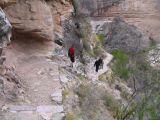 But we decided to
hire him anyway and he came to meet us early in the morning. Mario was in
his late 40s, not very tall but extremely light footed and he was dressed
for trekking. The only problem was that he only spoke Spanish so Ben Tore
had to translate.
Mario took us towards the canyon El Vergel, but on the way he took us past
a few dinosaur tracks. It’s amazing to see tracks made by these big
animals millions of years ago. If Torotoro is hoping for mass tourism they
will have to put up more signs so that the tracks are easier to find, and
more information about the tracks and the dinosaurs that made them.
But we decided to
hire him anyway and he came to meet us early in the morning. Mario was in
his late 40s, not very tall but extremely light footed and he was dressed
for trekking. The only problem was that he only spoke Spanish so Ben Tore
had to translate.
Mario took us towards the canyon El Vergel, but on the way he took us past
a few dinosaur tracks. It’s amazing to see tracks made by these big
animals millions of years ago. If Torotoro is hoping for mass tourism they
will have to put up more signs so that the tracks are easier to find, and
more information about the tracks and the dinosaurs that made them.
 It took us about an hour to reach the canyon and
the view was great. They have built steps that lead down to the bottom of
the canyon and we decided to check it out. At the bottom where the river
runs you can normally take a dip but at the time there was not a lot of
water in river. But there were cascades of water running out from the
sides of the canyon, and Tobbe used the opportunity to take a shower (just
to show off I imagine :-). Walking back up again was a bit harder than
going down. Torotoro is located at 2600 meters (8500 feet) so it was a bit
harder than usual to breath. Mario said to Ben Tore that he was impressed
that we were able to keep up with him…hey, what can I say…we’re Norwegians
:-) But we were sweating and breathing when we were walking…. Mario on the
other hand was totally unaffected by the walk.
It took us about an hour to reach the canyon and
the view was great. They have built steps that lead down to the bottom of
the canyon and we decided to check it out. At the bottom where the river
runs you can normally take a dip but at the time there was not a lot of
water in river. But there were cascades of water running out from the
sides of the canyon, and Tobbe used the opportunity to take a shower (just
to show off I imagine :-). Walking back up again was a bit harder than
going down. Torotoro is located at 2600 meters (8500 feet) so it was a bit
harder than usual to breath. Mario said to Ben Tore that he was impressed
that we were able to keep up with him…hey, what can I say…we’re Norwegians
:-) But we were sweating and breathing when we were walking…. Mario on the
other hand was totally unaffected by the walk.
 On the way back we also stopped by the Batea Cocha
rock paintings. We had looked for them the day before but if you don’t
know where to look, they can be easy to miss (at least when you are
walking around at dusk :-). I’m not sure how old these
paintings are but it shows that there have been people around in this area
for thousands of years. The paintings are made in red “painting” and shows
geometric figures and animals (if you use your imagination).
On the way back we also stopped by the Batea Cocha
rock paintings. We had looked for them the day before but if you don’t
know where to look, they can be easy to miss (at least when you are
walking around at dusk :-). I’m not sure how old these
paintings are but it shows that there have been people around in this area
for thousands of years. The paintings are made in red “painting” and shows
geometric figures and animals (if you use your imagination).
After 2 nights in Torotoro it was time to go back to La Paz again. We ate a last lunch at Lilly before we checked out. The 5 of us had 3 rooms for two nights, we had dinner/lunch/breakfast 2 times and we had gotten lots of drinking water. The total bill added up to 700 Bolivianos (about 90 US $). We walked in rain up to the landing strip again and the mud was just unbelivable...my shoes just got heavier and heavier :-) . Luckily Eugene had no problem landing the plane (even if parts of the landing strip also got extremely muddy). Due to bad weather we flew to Cochabamba instead of La Paz and once again Eugene flew low over the terrain before we dove into deep canyons and it was an amazing thrill ride. Riding in a small plane like this gives you quite a different experience with flying compared to flying in a larger plane.
Jesus and a disco taxi – short stop in
Cochabamba
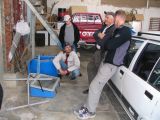 We landed in Cochabamba and parked at Eugen’s hangar. The flight from La
Paz to Salar De Uyuni, to Torotoro and the pick up cost us 150 US $ each.
In the hangar we got a demonstration of an invention of Eugen: the solar
oven. Being a missionary it seemed like he had a big heart and a desire to
try and help some of the poor in Bolivia. One of the challenges is making
food, as you need fuel (coal, wood, gas) and this either cost money or has
an effect on the environment. From this he has designed a simple solar
oven that looks like a suitcase. The sun is strong in Bolivia, and the
oven keeps the heat in a pressurized chamber which let you cook food for
3-4 hours. And once you bought it you can of course use it for free. I
really hope that he gets to promote the idea to someone that can bring
this out to the thousands that need it.
We landed in Cochabamba and parked at Eugen’s hangar. The flight from La
Paz to Salar De Uyuni, to Torotoro and the pick up cost us 150 US $ each.
In the hangar we got a demonstration of an invention of Eugen: the solar
oven. Being a missionary it seemed like he had a big heart and a desire to
try and help some of the poor in Bolivia. One of the challenges is making
food, as you need fuel (coal, wood, gas) and this either cost money or has
an effect on the environment. From this he has designed a simple solar
oven that looks like a suitcase. The sun is strong in Bolivia, and the
oven keeps the heat in a pressurized chamber which let you cook food for
3-4 hours. And once you bought it you can of course use it for free. I
really hope that he gets to promote the idea to someone that can bring
this out to the thousands that need it.
According to Ben Tore there is only one thing to
see in Cochabamba: the Jesus statue. The only time I have heard of the
city before was through the movie Scarface when Al Pacino is visiting to
pick up drugs. Back to the Jesus figure: it is known as Cristo de la
Concordia and it is actually bigger than the one in Rio De Janeiro. At
about 34 meters it is the largest in the world. From what I understand the
figure in Rio is 33 meters tall to symbolize the age of Jesus Christ when
he was crucified. The people in Cochabamba had a different logic…after all
Jesus was not exactly 33…he was 33 and a bit and hence they could make it
taller :-)
Eugen was kind to drive us to the cable car that
goes up to Cristo de la Concordia. In case you wonder…Eugen drove a Volvo,
of course :-) The ticket was 3 Bol each for the cable car (about 40 US
cent). We didn’t stay long at the top… took some pictures and looked at
the view.
After a quick meal we grabbed a taxi to go to the airport. As usual we
squeezed in all 5 of us in a regular car and the driver didn’t have any
problems with that. He was playing disco music and I think he was a bit
surprised when we could join in on Baccara’s hit “Yes Sir, I can boogie”
:-)
We got tickets back to La Paz with Lloyd Aereo Boliviano (aka LAB) for 400 Bolivianos each (50 US dollars). The flight was only 40 minutes in a 727. The weather was bad when we were landing in La Paz and it must have been one of the worse landings that I have ever experienced. The pilot slammed the plane so hard down that we practically bounced up again. Luckily the airstrip is quite long and soon we were back in our beds at Casa Alianza.
Conquering Chacaltaya
 At this point we were getting close to the end of our vacation. It was
Friday September 29th and we had to make up our minds what we wanted to do
for the last remaining days. We all agreed that we wanted to check out the
peak Chacaltaya which is located right outside town. Once again it was
great that Ben Tore had a Toyota LandCruiser, as it had snowed the night
before. But with his 4X4 we climbed the road all the way up to the club
house of Club Andino Boliviano at 5300 meter (17388 feet).
At this point we were getting close to the end of our vacation. It was
Friday September 29th and we had to make up our minds what we wanted to do
for the last remaining days. We all agreed that we wanted to check out the
peak Chacaltaya which is located right outside town. Once again it was
great that Ben Tore had a Toyota LandCruiser, as it had snowed the night
before. But with his 4X4 we climbed the road all the way up to the club
house of Club Andino Boliviano at 5300 meter (17388 feet).
Because of the
weather conditions we were the only ones there! According to
Wikipedia the
glacier on Chacaltaya is the only ski area in Bolivia, and it has the
world's highest lift-served ski area as well as the most equatorial. Well,
I can tell you that there is not much of a lift left at the moment. Part
of our group walked up on the mountain, and on the top you are on 5421
meters above sea level (17785 feet). I was pretty much prepared for the
short walk…well, apart from the fact that I didn’t have proper shoes. But
for a short walk it was not a problem. There is even a service at the club
house if you want to have a Coke or beer after the climb :-)
A night out on the town - Mongo’s Rock bottom
café
During our stay at Casa Alianza the others raved about the popular hang
out spot Mongo’s Rock bottom café. So we decided to check it out on the
last weekend we had in La Paz. We arrived early to get something to eat.
It was a very cozy place with wooden furniture, lots of decorations, fire
places etc. It seems to be a popular place for expats so they served
western type food. We ended up having salads, burgers etc. After a while
the place started filling up and we were also joined by some of the others
from Casa Alianza. For some odd reason my memory is a bit blurry when it
comes to this evening especially after Tobbe ordered a bottle of Absolute
vodka :-) We just asked to have lots of ice cubes and Redbull available in
order to mix our own drinks. The waitress seemed to have a blast just
looking at the bunch of crazy Norwegians having a party :-)
Finally – sightseeing in La Paz
 We had been on a tight schedule most of the time so we never actually had
time to check out the sights of La Paz on foot. Towards the end of the
trip we got a chance to check it out. Olav and myself took a taxi from the
Obrajes district where Casa Alianza is located to Plaza San Fransisco. The
taxi ride was 12 Bolivianos (about 1.5 US $). The taxis don’t have a meter
but they run on different zones in town. In general it was very cheap to
take a taxi around.
We had been on a tight schedule most of the time so we never actually had
time to check out the sights of La Paz on foot. Towards the end of the
trip we got a chance to check it out. Olav and myself took a taxi from the
Obrajes district where Casa Alianza is located to Plaza San Fransisco. The
taxi ride was 12 Bolivianos (about 1.5 US $). The taxis don’t have a meter
but they run on different zones in town. In general it was very cheap to
take a taxi around.
 We started by walking to the Mercado de hechiceria
(witches’ market). I guess the market got its name as they sell stuff that
is used according to local folklore and beliefs. So here you can buy
articles like different herbs, figures etc but I guess the most striking
item is llama fetuses.
We started by walking to the Mercado de hechiceria
(witches’ market). I guess the market got its name as they sell stuff that
is used according to local folklore and beliefs. So here you can buy
articles like different herbs, figures etc but I guess the most striking
item is llama fetuses.
 If you are opening a new business you can buy a
llama fetus and bury this under the corner stone, which is supposed to
bring good fortune. It was a bit weird to see all these small llamas
hanging around for sale. But there was also knitted stuff for sale,
instruments, wooden figures etc. We also stopped by the
coca museum of La
Paz which is located in the same area. The
entrance fee was only 8 Bolivianos and the museum is quite small. But it
does give a pretty informative picture of the coca plant, how it has been
used, how it is turned into cocaine etc.
If you are opening a new business you can buy a
llama fetus and bury this under the corner stone, which is supposed to
bring good fortune. It was a bit weird to see all these small llamas
hanging around for sale. But there was also knitted stuff for sale,
instruments, wooden figures etc. We also stopped by the
coca museum of La
Paz which is located in the same area. The
entrance fee was only 8 Bolivianos and the museum is quite small. But it
does give a pretty informative picture of the coca plant, how it has been
used, how it is turned into cocaine etc.
From here we went to the Mercado Negro. This is a huge market and it is crowded. Here you can buy everything from shoes and clothing to toys, food, kitchen stuff etc. I didn’t buy anything but it was fun just walking around looking at all the activity. I was even offered marijuana from a guy. He came over to me and asked me about Mary Jane and I’m like “sorry, don’t know what you are talking about”. Olav just smiled and wonder how I was able to be so naïve :-)
 We also walked up to Plaza Pedro D
Murillo to look
at the cathedral and the presidential palace. We had to take it a bit easy
when walking around – it’s all uphill or downhill. Figuring out what to
wear is also a challenge, as the sun is strong. But once you get into the
shadows it can be quite cold. We walked over to the cathedral built in
1835. The most stunning feature of the building is that it is located on a
hill side (like most other buildings in La Paz) but it is very apparent on
this large structure. According to the Lonely Planet book the base of the
building is 12 meters lower (40 feet) than the entrance on the other side
of the building! We never did get into the church as it seemed to be
closed when we were there.
We also walked up to Plaza Pedro D
Murillo to look
at the cathedral and the presidential palace. We had to take it a bit easy
when walking around – it’s all uphill or downhill. Figuring out what to
wear is also a challenge, as the sun is strong. But once you get into the
shadows it can be quite cold. We walked over to the cathedral built in
1835. The most stunning feature of the building is that it is located on a
hill side (like most other buildings in La Paz) but it is very apparent on
this large structure. According to the Lonely Planet book the base of the
building is 12 meters lower (40 feet) than the entrance on the other side
of the building! We never did get into the church as it seemed to be
closed when we were there.
When we came back to Casa Alianza after a long day we met Svein and Tobbe and we summarized what we had done. We were quite surprised when it turned out that we had gone to the same places…and I mean down to the last details such as lunch at Burger King and coffee at Café Le Terraza. I guess great minds think alike…or maybe we had just spent too much time together :-)
In the evening we had a goodbye dinner with Ben
Tore and his wife at an art café called La Comedie. We had to pay 1000
Bolivianos for the 6 of us (about 125 US dollars) and that included 2
bottles of red wine and large portions. I had a ham overload for starters
and I followed the chef’s recommendation and had goat for the main meal.
It was a good meal, although the chocolate fondant for dessert was not
that impressive (I prefer the one that I make myself :-)
Time to go home
Early Monday morning October 2nd we got up at 3.30 AM to drive to the
airport. Get there early because checking in takes forever. We also had to
pay 25 US $ each as a departure tax. As the sun rose we took off from La
Paz and got a lovely view of the city and the surrounding mountains. We
had to make a stop in Santa Cruz…I guess the planes can’t take off with
maximum load at the high altitude of La Paz. It took an hour down to Santa
Cruz and after 1 hour on the ground we were off towards Miami :-) We got a
great view of parts of South America on the way as well…the coast line of
Venezuela, Jamaica, Cuba etc.
We spent a few hours in the Admirals Club in the Miami airport before taking the Boeing 777 from American Airlines to London. We took off in the evening and there were millions of street lights around the Miami area. Quite a contrast to what we had experienced in Bolivia and Peru.
Conclusion
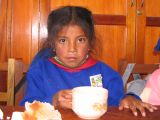 I have to say that this trip was amazing. When we were traveling we
referred to our trip as an adventure or expedition and not a vacation.
Thanks to Ben Tore I think we got to see places and experience things that
would have been very difficult without a “local” contact. Coming to these
countries was a bit of a culture shock for us. There were things that were
very different compared to back home: traffic lights operated by traffic
police, the shoe polisher boys in their ski masks, heavily armed police
around the presidential palace, the poor areas in El Alto, the language
etc. About the language…if you know your Spanish it will be a lot easier
for you to enjoy a trip to Bolivia and Peru. Our Spanish is very limited
and we had to rely on Ben Tore to translate a lot for us as there were not
that many people that spoke English.
I have to say that this trip was amazing. When we were traveling we
referred to our trip as an adventure or expedition and not a vacation.
Thanks to Ben Tore I think we got to see places and experience things that
would have been very difficult without a “local” contact. Coming to these
countries was a bit of a culture shock for us. There were things that were
very different compared to back home: traffic lights operated by traffic
police, the shoe polisher boys in their ski masks, heavily armed police
around the presidential palace, the poor areas in El Alto, the language
etc. About the language…if you know your Spanish it will be a lot easier
for you to enjoy a trip to Bolivia and Peru. Our Spanish is very limited
and we had to rely on Ben Tore to translate a lot for us as there were not
that many people that spoke English.
 In some ways I guess Bolivia is a bit like Norway.
Both countries can offer stunning landscapes and beautiful mountains.....and
not that much else. But due to a combination of luck and good management
Norway has become a rich country while Bolivia is still quite poor. But
when we visited the school at El Alto and the kids were laughing and
eating cake we came to the conclusion that even if they don't have a lot
of money, they are not poor. I guess this is a reminder that you don’t have to have lots of
things and money to enjoy life.
In some ways I guess Bolivia is a bit like Norway.
Both countries can offer stunning landscapes and beautiful mountains.....and
not that much else. But due to a combination of luck and good management
Norway has become a rich country while Bolivia is still quite poor. But
when we visited the school at El Alto and the kids were laughing and
eating cake we came to the conclusion that even if they don't have a lot
of money, they are not poor. I guess this is a reminder that you don’t have to have lots of
things and money to enjoy life.
 As usual it would have been great to have more
time. If I had time and equipment I would probably have given Huayna
Potosi a try. This mountain is 6088 meters high (19973 feet) and it is
said to be one of the easiest 6000 meter mountains in the world. A couple
at Casa Alianza did give it a try during our stay, but they had to give it
up as the one girl lost her jacket when she had a pee break :-) It would also have been great if we had more time
to explore the ruins around Tiahuanaco. This is a pre-Inca culture near
Lake Titicaca and we only got to see it when driving by on our trip to
Peru. In Peru I would also have tried to go to Nazca to check out the
Nazca lines if I had the time.
As usual it would have been great to have more
time. If I had time and equipment I would probably have given Huayna
Potosi a try. This mountain is 6088 meters high (19973 feet) and it is
said to be one of the easiest 6000 meter mountains in the world. A couple
at Casa Alianza did give it a try during our stay, but they had to give it
up as the one girl lost her jacket when she had a pee break :-) It would also have been great if we had more time
to explore the ruins around Tiahuanaco. This is a pre-Inca culture near
Lake Titicaca and we only got to see it when driving by on our trip to
Peru. In Peru I would also have tried to go to Nazca to check out the
Nazca lines if I had the time.
But all in all I don’t think we could have gotten
a better trip. A big thank you to Ben Tore and his family for helping us
out in planning the trip, showing us around in La Paz and bringing us
around to places that we would never have gotten to see without him. And I
would also like to send a big thank you to the others in the group that I
traveled with. They all made this out to be a trip that I will remember
for a long long time. Please get in touch on
gardkarlsen@hotmail.com if
you have any questions or comments and I'll do my best to answer.
Some useful tips:
-
Check out the Google map that I have made. Remember that this is interactive and you can zoom in and out, click on the markers etc
- Would you like to print this trip report? Check out this PDF version of the trip report
- Would you like to read a different trip report? Check out Sandy's experience from Bolivia when she went there in 2006.
- Wondering what the weather will be like in Bolivia? Check out weatherbase.com
- Which forums to ask questions: Try TripAdvisor, Fodor’s, SlowTalk and Frommer’s
- Do you wonder how far it is from one place to another in La Paz? Check out this tool Google map tool. With this you can zoom in on La Paz (or any other place) and measure distances from one attraction to another.
- Another useful page is mapfrappe.com . On this page there are two maps...first indicate a know area on the top map (e.g. an area of NYC)...and then zoom in on Rome on the lower map. Now you will get an outline of NYC on e.g La Paz and that should give you an idea when it comes to size.
- Be careful when you get cash in Bolivia. We got a fake 100 US $ bill at an ATM!
- Remember that at most toilets the toilet paper goes into the bucket next to the toilet and are not meant to be flushed down.
- If you don’t want to chew coke leaves you can also find coke tea :-)